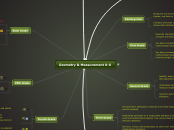Geometry & Measurement K-6
Kindergarten
First Grade
Describe characteristics of basic shapes. Use basic shapes to compose and decompose other objects in various contexts.
Use basic concepts of measurement in real-world and mathematical situations involving length, time and money.
Measurement
Use basic concepts of measurement in real-world and mathematical situations.
involving length, time and money.
Second Grade
Third Grade
Understand perimeter as a measurable attribute of real- world and mathematical objects. Use various tools to measure distances.
Use time, money and temperature to solve real- world and mathematical problems.
Sixth Grade
Calculate perimeter, area, surface area and volume of two- and three- dimensional figures to solve real-world and mathematical problems.
Choose appropriate units of measurement and use ratios to convert within measurement systems to solve real-world and mathematical problems.
Fifth Grade
Determine the area of triangles and quadrilaterals;
determine the surface area and
volume of rectangular prisms in various contexts.
Fourth Grade
Resource
Understand angle Geometry & and area as
Measurement measurable attributes of real-
world and mathematical objects. Use various tools to measure angles and areas.
Use translations, reflections and rotations to establish congruency and understand symmetries.
Homework Help for Students and Parents
Virtual Manipulatives
Glencoe
University of Missouri
Classroom Visual Posters







